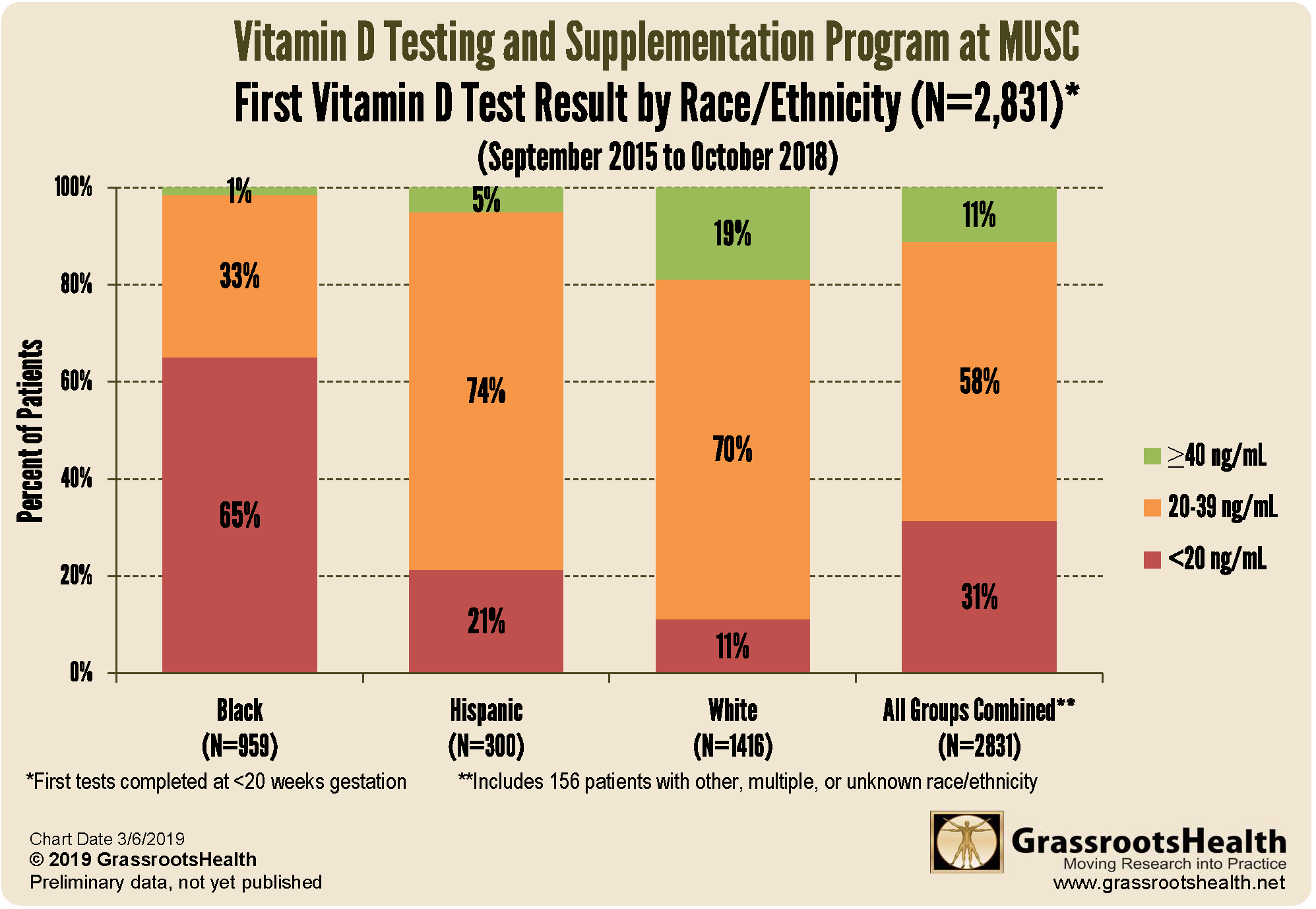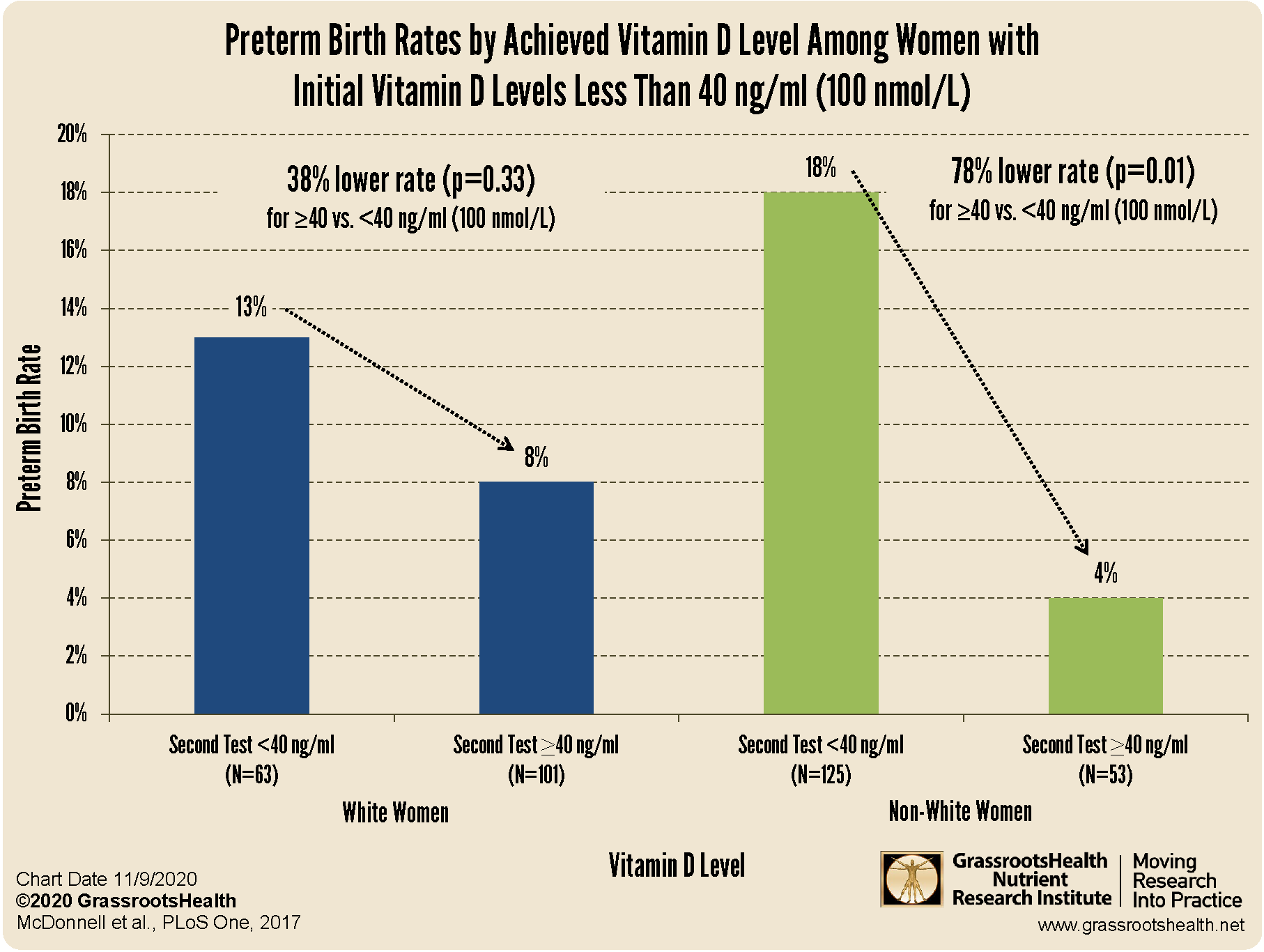Published on April 12, 2024
Black Maternal Health Week is April 11-17th: Help share information on this important initiative with the information included in this email
Key Points
- The risk of vitamin D deficiency is greatest for Blacks, making the benefits of getting enough vitamin D even more substantial for this group of individuals; vitamin D supplementation is safe, effective, and inexpensive – and it alone can make a HUGE difference in the health of a mother and her child
- Among pregnant women receiving routine prenatal vitamin D testing, a vast majority (89%) had vitamin D levels less than 40 ng/ml on their first vitamin D test and almost one-third (31%) had vitamin D levels less than 20 ng/ml. Black women had particularly low vitamin D levels; almost all (99%) were less than 40 ng/ml and approximately two-thirds (65%) were less than 20 ng/ml.
- In a study looking at preterm birth risk, for women with vitamin D levels at or above 40 ng/ml compared to less than 20 ng/ml, there was a 65% lower risk of preterm birth among white women and a 68% lower risk among non-white women; the similar decreased risk when getting the serum level up during pregnancy suggests that improvements in vitamin D status may decrease the disparity in preterm birth rates between racial/ethnic groups – in other words, there was NO difference in preterm birth rates by ethnicity if vitamin D levels were equal
 It is Black Maternal Health Week (April 11-17, 2024), and GrassrootsHealth would very much appreciate your help in sharing the research that demonstrates the immense benefits of optimal vitamin D levels to the health of both mother and child during this special time. The risk of vitamin D deficiency is greatest for Blacks, making the benefits of getting enough vitamin D even more substantial for this group of individuals.
It is Black Maternal Health Week (April 11-17, 2024), and GrassrootsHealth would very much appreciate your help in sharing the research that demonstrates the immense benefits of optimal vitamin D levels to the health of both mother and child during this special time. The risk of vitamin D deficiency is greatest for Blacks, making the benefits of getting enough vitamin D even more substantial for this group of individuals.
Vitamin D supplementation is safe, effective, and inexpensive – and it alone can make a HUGE difference in the health of a mother and her child. Take a look at the studies and resources below and choose which you would like to share. Easily share any of our blogs using the share buttons at the top right of each article.
We thank you for your advocacy!
How Much Could Increasing Vitamin D Levels Among Black Women Improve Prenatal Outcomes?
Below, we share our own research showing the gap in preterm birth outcomes between white and black mothers – a gap that virtually disappears when vitamin D deficiency is corrected.
First Trimester Vitamin D Levels
Among pregnant women receiving routine prenatal vitamin D testing, a vast majority (89%) had vitamin D levels less than 40 ng/ml on their first vitamin D test and almost one-third (31%) had vitamin D levels less than 20 ng/ml. Black women had particularly low vitamin D levels; almost all (99%) were less than 40 ng/ml and approximately two-thirds (65%) were less than 20 ng/ml. These vitamin D levels are representative of prenatal vitamin D levels across the United States.
How Do Race and Vitamin D Levels Affect the Risk of Having a Preterm Baby?
We have previously summarized the main results from a published GrassrootsHealth study showing a 62% lower risk of preterm birth for women with vitamin D levels at or above 40 ng/ml (100 nmol/L) compared to women with levels less than 20 ng/ml. Below, we look at another analysis from that paper which assessed the association between vitamin D and preterm birth risk for white and non-white women. This was important to look at due to the racial and ethnic differences in preterm birth rates, with Black women having higher rates compared to other groups.
Among the 1,064 women in the study, 10% of white women and 15% of non-white women had a preterm birth. Black women accounted for a majority (69%) of the non-white births and had a 19% preterm birth rate. For those with vitamin D levels at or above 40 ng/ml compared to women with levels less than 20 ng/ml, there was a 65% lower risk of preterm birth among white women and a 68% lower risk among non-white women. The similar decreased risk suggests that improvements in vitamin D status may decrease the disparity in preterm birth rates between racial/ethnic groups.
As illustrated in the chart above, among women whose initial vitamin D level was less than 40 ng/ml, the preterm birth rate was 38% lower among white women and 78% lower among non-white women for those who raised their level to at least 40 ng/ml prior to giving birth vs. those who did not.
This indicates that improving the vitamin D status of non-white women, who are more likely to have low vitamin D levels, could dramatically decrease racial disparities in preterm birth rates.
Getting Technical: Vitamin D Level Alone Made a Difference
The most telling part of this analysis comes toward the end of the results section of the paper:
Differences by race/ethnicity were not statistically significant when 25(OH)D concentration was included as a covariate in multivariable regression analysis.
To a statistician this statement means…
there was NO difference in preterm birth rates (what was measured in the study) by ethnicity if vitamin D levels were equal.
This statement is the key to disparity and the plausible conclusion that getting vitamin D levels into recommended ranges (40-60 ng/ml) alone could even out health and mortality risks among these ethnicities.
One Simple Change Makes a BIG Difference
It should be clear that vitamin D alone has the potential to make a big difference in health outcomes, especially for pregnant and black individuals. Learn why are blacks more deficient in vitamin D and what can be done to address this issue for all! See the study reviews and resources below for more ways to share this vital information about vitamin D during pregnancy over the next week for Black Maternal Health!
Additional Study Findings to Share Using the Share Buttons on Each Blog!
Increasing Vitamin D Levels Could Virtually Eliminate Racial Health Disparities
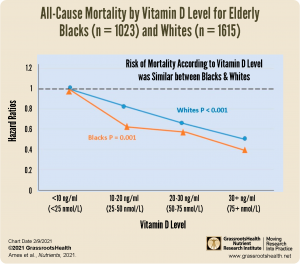 A summary of research and charts illustrating the gap in health outcomes and mortality between blacks and whites – a gap that virtually disappears when vitamin D deficiency is corrected
A summary of research and charts illustrating the gap in health outcomes and mortality between blacks and whites – a gap that virtually disappears when vitamin D deficiency is corrected
Key Points
- Blacks are the most at risk of vitamin D deficiency of all ethnicities
- There is strong evidence that getting vitamin D levels among blacks up to at least 30-40 ng/ml (75-100 nmol/L) alone may eliminate much of the health disparities seen between blacks and whites; one study found a 61% lower risk of mortality for blacks and a 50% lower risk of mortality for whites when vitamin D levels were increased from less than 10 ng/ml (25 nmol/L) to at 30 ng/ml (75 nmol/L) or above
- A study found that pregnant women with vitamin D levels at or above 40 ng/ml compared to women with levels less than 20 ng/ml had a 65% lower risk of preterm birth among white women (p=0.03) and a 68% lower risk among non-white women (p=0.008)
- There was NO difference in preterm birth rates (what was measured in the study) by ethnicity if vitamin D levels were equal; we can erase disparity in preterm birth caused by vitamin D deficiency, according to this analysis, by bringing everyone’s vitamin D levels to at least 40 ng/ml
A Time Especially Sensitive to Vitamin D – When Deficiency Can Result in Life-Long Consequences
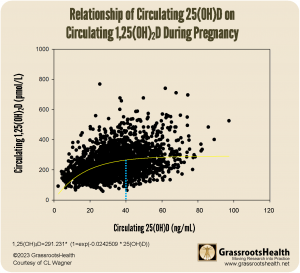 Some of the most compelling evidence of the need for a minimum vitamin D level of 40 ng/ml (100 nmol/L)… How fulfilling the unique need for vitamin D during pregnancy can impact prenatal, newborn & lifelong health
Some of the most compelling evidence of the need for a minimum vitamin D level of 40 ng/ml (100 nmol/L)… How fulfilling the unique need for vitamin D during pregnancy can impact prenatal, newborn & lifelong health
Key Points
- During pregnancy, conversion of 25(OH)D to the hormonal form, 1,25(OH)2D, increases so that by 12 weeks, levels in the blood are triple that of normal, non-pregnant female and normal male subjects; in a non-pregnant person, these levels would result in toxicity and potential death, but these are perfectly normal levels during pregnancy that are only allowed to optimize with a minimum 25(OH)D vitamin D level of 40 ng/ml
- When there is enough vitamin D3 available during pregnancy, 25(OH) vitamin D levels are allowed to rise and peak towards the end of pregnancy; this peak is prevented when vitamin D3 is limited and vitamin D levels are too low
- Globally, there is a high prevalence of deficiency among pregnant women; one study found 10% of all, 51% of women born in Africa, and 46% of women born in Asia were severely deficient (<12 ng/ml or <30 nmol/L)
Black Women Could Lower their Risk of Preterm Birth by 78%
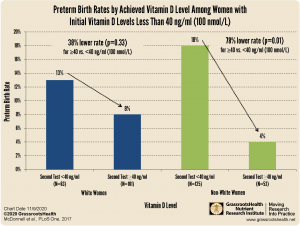 A greatest impact on maternal and infant health could be made simply by addressing vitamin D deficiency among Blacks!
A greatest impact on maternal and infant health could be made simply by addressing vitamin D deficiency among Blacks!
Key Points
- Approximately 68% of Black women have vitamin D levels below 20 ng/ml (50 nmol/L) and at these levels, would be expected to have a 20% preterm birth rate
- Among women whose initial vitamin D level was less than 40 ng/ml, the preterm birth rate was 38% lower for white women and 78% lower for non-white women if they raised their level to at least 40 ng/ml prior to giving birth vs. those who did not
- Women with vitamin D levels at or above 40 ng/ml compared to women with levels less than 20 ng/ml had a 65% lower risk of preterm birth among white women and a 68% lower risk among non-white women
- There was NO difference in preterm birth rates (what was measured in the study) by ethnicity if vitamin D levels were equal; we can erase disparity in preterm birth caused by vitamin D deficiency, according to this analysis, by bringing everyone’s vitamin D levels to at least 40 ng/ml
Cesarean Section, Preeclampsia, and Preterm Birth Increased among Women with Lower Vitamin D Levels
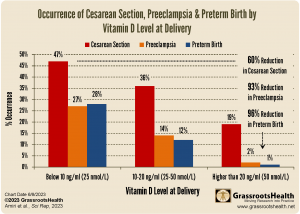 New study finds 60% reduction in cesarean section, 93% reduction in preeclampsia, and 96% reduction in preterm birth among women whose vitamin D level was higher than 20 ng/ml vs below 10 ng/ml at birth
New study finds 60% reduction in cesarean section, 93% reduction in preeclampsia, and 96% reduction in preterm birth among women whose vitamin D level was higher than 20 ng/ml vs below 10 ng/ml at birth
Key Points
- Maintaining healthy vitamin D levels of at least 40 ng/ml or 100 nmol/L throughout pregnancy is essential to prenatal and newborn health
- A new study showed that women with moderate and severe vitamin D deficiency at the time of delivery had much higher rates of cesarean section, preeclampsia, and preterm delivery compared to women with higher vitamin D levels; the study also found significantly higher rates of pregnancy complications, such as gestational diabetes and low birth weight, among women who had not been receiving vitamin D during pregnancy
- Women whose vitamin D level was higher than 20 ng/ml at the time of delivery experienced a 60% reduction in cesarean section, 93% reduction in preeclampsia, and 96% reduction in preterm birth, compared to women whose vitamin D level was below 10 ng/ml
New RCT Demonstrates Benefits of Vitamin D Supplementation Starting Early in Pregnancy
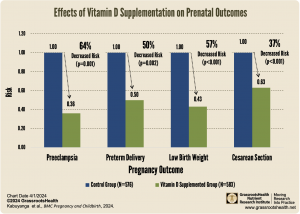 Women given vitamin D throughout pregnancy experienced significantly decreased risks of preeclampsia, preterm delivery, low birth weight, cesarean section and more
Women given vitamin D throughout pregnancy experienced significantly decreased risks of preeclampsia, preterm delivery, low birth weight, cesarean section and more
Key Points
- A newly published randomized controlled trial (RCT) by Kabuyanga et al. demonstrated the effects of vitamin D supplementation among pregnant women in the Eastern Democratic Republic of the Congo found that, compared to women who did not receive vitamin D, those receiving vitamin D experienced a 64% decreased risk of preeclampsia, 50% decreased risk of preterm delivery, 37% decreased risk of cesarean section, and more
- 20% of the women in the vitamin D supplementation group were still vitamin D deficient at the end of the study, indicating the need for higher doses of vitamin D during pregnancy; Weiss et al. found that a higher dose of 4400 IU vitamin D per day was still not optimal for all pregnant women, leaving 25% below 30 ng/ml, and African American women had the lowest levels overall
Vitamin D Protects Against Complications of Pregnancy
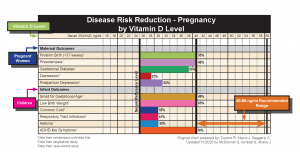 This updated illustration shows why it is important to ensure vitamin D levels are 40-60 ng/ml (100-150 nmol/L) for a healthy pregnancy and baby
This updated illustration shows why it is important to ensure vitamin D levels are 40-60 ng/ml (100-150 nmol/L) for a healthy pregnancy and baby
Numerous studies have found that higher vitamin D levels among pregnant women reduce the risk of adverse maternal and infant outcomes. We reviewed and compiled many of these findings to create an updated version of the Pregnancy Disease Risk Reduction Chart below.
For Sharing on Social Media
Follow us on Social Media to like and share our posts, create your own posts to share, or save (right-click) and share the following on your own accounts throughout the week! (More to come throughout the week…)
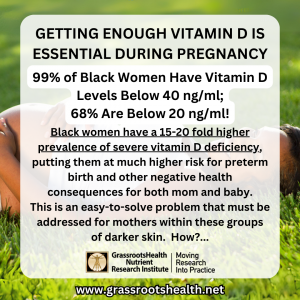 | 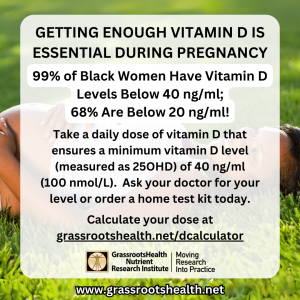 | 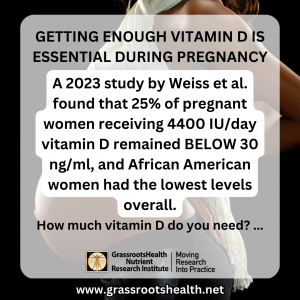 |
|---|---|---|
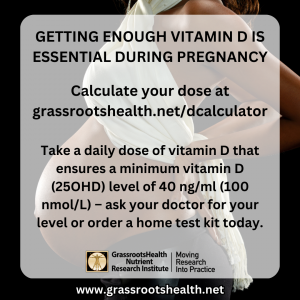 | 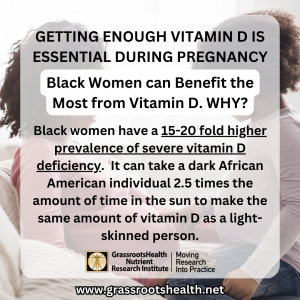 | 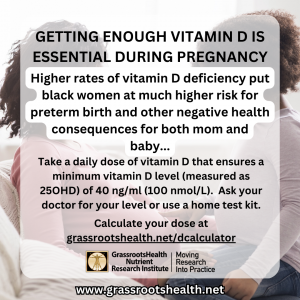 |
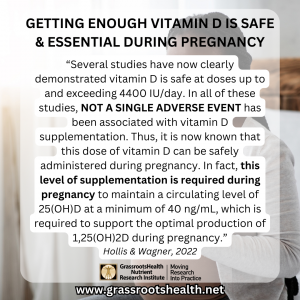 | 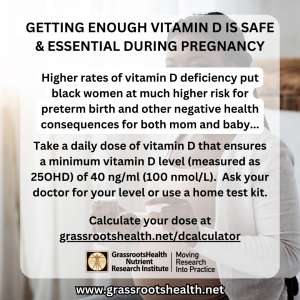 | 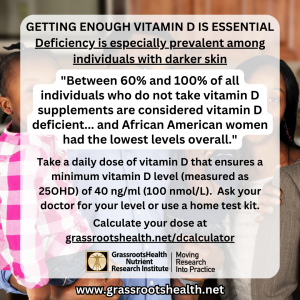 |
How Are Your Levels of Vitamin D and Other Important Nutrients?
Do you know what your vitamin D level is? Check yours along with omega-3s, magnesium, and other levels today as part of the vitamin D*action project; add the Ratios for more about how to balance your Omega-3s and 6s!
Measure your:
- Vitamin D
- Magnesium PLUS Elements
- Omega-3 Fatty Acids
- hsCRP (for Inflammation)
- HbA1c (for Blood Sugar)
- and more
Did you know that each of the above can be measured at home using a simple blood spot test? As part of our ongoing research project, you can order your home blood spot test kit to get your levels, followed by education and steps to take to help you reach your optimal target levels. Start by enrolling and ordering your kit to measure each of the above important markers, and make sure you are getting enough of each to support better mood and wellbeing!
Build your custom kit here – be sure to include your Omega-3 Index along with your vitamin D.
Start Here to Measure Your Levels


